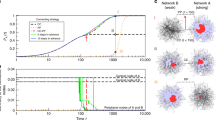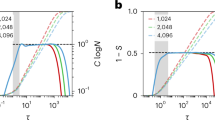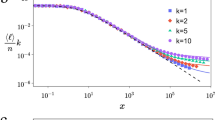Abstract
Dynamical reaction–diffusion processes and metapopulation models are standard modelling approaches for a wide array of phenomena in which local quantities—such as density, potentials and particles—diffuse and interact according to the physical laws. Here, we study the behaviour of the basic reaction–diffusion process (given by the reaction steps B→A and B+A→2B) defined on networks with heterogeneous topology and no limit on the nodes’ occupation number. We investigate the effect of network topology on the basic properties of the system’s phase diagram and find that the network heterogeneity sustains the reaction activity even in the limit of a vanishing density of particles, eventually suppressing the critical point in density-driven phase transitions, whereas phase transition and critical points independent of the particle density are not altered by topological fluctuations. This work lays out a theoretical and computational microscopic framework for the study of a wide range of realistic metapopulation and agent-based models that include the complex features of real-world networks.
This is a preview of subscription content, access via your institution
Access options
Subscribe to this journal
Receive 12 print issues and online access
$209.00 per year
only $17.42 per issue
Buy this article
- Purchase on Springer Link
- Instant access to full article PDF
Prices may be subject to local taxes which are calculated during checkout




Similar content being viewed by others
References
Marro, J. & Dickman, R. Nonequilibrium Phase Transitions in Lattice Models (Cambridge Univ. Press, Cambridge, 1999).
van Kampen, N. G. Stochastic Processes in Chemistry and Physics (North Holland, Amsterdam, 1981).
Murray, J. D. Mathematical Biology 3rd edn (Springer, Berlin, 2005).
Anderson, R. M. & May, R. M. Infectious Diseases of Humans: Dynamics and Control (Oxford Univ. Press, Oxford, 1992).
Anderson, R. M. & May, R. M. Spatial heterogeneity and the design of immunization programs. Math Biosci. 72, 83–111 (1984).
Bolker, B. M. & Grenfell, B. T. Space persistence and dynamics of measles epidemics. Phil. Trans. R. Soc. Lond. B 348, 309–320 (1995).
Lloyd, A. L. & May, R. M. Spatial heterogeneity in epidemic models. J. Theor. Biol. 179, 1–11 (1996).
Grenfell, B. T. & Bolker, B. M. Cities and villages: Infection hierarchies in a measles meta-population. Ecol. Lett. 1, 63–70 (1998).
Keeling, M. J. & Rohani, P. Estimating spatial coupling in epidemiological systems: A mechanistic approach. Ecol. Lett. 5, 20–29 (1995).
Ferguson, N. M. et al. Planning for smallpox outbreaks. Nature 425, 681–685 (2003).
Liljeros, F., Edling, C. R., Amaral, L. A. N., Stanley, H. E. & Åberg, Y. The web of human sexual contacts. Nature 411, 907–908 (2001).
Schneeberger, A. et al. Scale-free networks and sexually transmitted diseases: A description of observed patterns of sexual contacts in Britain and Zimbabwe. Sex. Transm. Dis. 31, 380–387 (2004).
Barrat, A., Barthélemy, M., Pastor-Satorras, R. & Vespignani, A. The architecture of complex weighted networks. Proc. Natl Acad. Sci. USA 101, 3747–3752 (2004).
Guimerà, R., Mossa, S., Turtschi, A. & Amaral, L. A. N. The worldwide air transportation network: Anomalous centrality, community structure, and cities’ global roles. Proc. Natl Acad. Sci. USA 102, 7794–7799 (2005).
Chowell, G., Hyman, J. M., Eubank, S. & Castillo-Chavez, C. Scaling laws for the movement of people between locations in a large city. Phys. Rev. E 68, 066102 (2003).
Albert, R. & Barabási, A.-L. Statistical mechanics of complex networks. Rev. Mod. Phys. 74, 47–97 (2002).
Newman, M. E. J. The structure and function of complex networks. SIAM Rev. 45, 167–256 (2003).
Dorogovtsev, S. N. & Mendes, J. F. F. Evolution of Networks: From Biological Nets to the Internet and WWW. (Oxford Univ. Press, Oxford, 2003).
Pastor-Satorras, R. & Vespignani, A. Evolution and Structure of the Internet: A Statistical Physics Approach (Cambridge Univ. Press, Cambridge, 2004).
Barrett, C. L. et al. TRANSIMS: Transportation Analysis Simulation System (Technical Report LA-UR-00-1725, Los Alamos National Laboratory, 2000).
Cohen, R., Erez, K., ben-Avraham, D. & Havlin, S. Resilience of the Internet to random breakdowns. Phys. Rev. Lett. 85, 4626–4628 (2000).
Callaway, D. S., Newman, M. E. J., Strogatz, S., H. & Watts, D. J. Network robustness and fragility: Percolation on random graphs. Phys. Rev. Lett. 85, 5468–5471 (2000).
Pastor-Satorras, R. & Vespignani, A. Epidemic spreading in scale-free networks. Phys. Rev. Lett. 86, 3200–3203 (2001).
Cardy, J. L. & Grassberger, P. Epidemics models and percolation. J. Phys. A 18, L267–L271 (1985).
de Freitas, J. E., Lucena, L. S., da Silva, L. R. & Hilhorst, H. J. Critical behavior of a two-species reaction-diffusion problem. Phys. Rev. E 61, 6330–6336 (2000).
Pastor-Satorras, R. & Vespignani, A. Field theory of absorbing phase transitions with a nondiffusive conserved field. Phys. Rev. E 62, R5875–R5878 (2000).
Kree, R., Schaub, B. & Schmittman, B. Effects of pollution on critical population dynamics. Phys. Rev. A 39, 2214–2221 (1989).
van Wijland, F., Oerding, K. & Hilhorst, H. J. Wilson renormalization of a reaction-diffusion process. Physica A 251, 179–201 (1998).
Rvachev, L. A. & Longini, I. M. A mathematical model for the global spread of influenza. Math. Biosci. 75, 3–22 (1985).
Hufnagel, L., Brockmann, D. & Geisel, T. Forecast and control of epidemics in a globalized world. Proc. Natl Acad. Sci. USA 101, 15124–15129 (2004).
Colizza, V., Barrat, A., Barthélemy, M. & Vespignani, A. The role of the airline transportation network in the prediction and predictability of global epidemics. Proc. Natl Acad. Sci. USA 103, 2015–2020 (2006).
Pastor-Satorras, R., Vázquez, A. & Vespignani, A. Dynamical and correlation properties of the internet. Phys. Rev. Lett. 87, 258701 (2001).
Newman, M. E. J. Assortative mixing in networks. Phys. Rev. Lett. 89, 208701 (2002).
Catanzaro, M., Boguna, M. & Pastor-Satorras, R. Generation of uncorrelated random scale-free networks. Phys. Rev. E 71, 027103 (2005).
Molloy, M. & Reed, B. A critical point for random graphs with a given degree sequence. Random Struct. Algorithms 6, 161–179 (1995).
Acknowledgements
A.V. is partially supported by the NSF award IIS-0513650. R.P.-S. acknowledges financial support from the Spanish MEC (FEDER), under project No. FIS2004-05923-C02-01 and additional support from the DURSI, Generalitat de Catalunya (Spain).
Author information
Authors and Affiliations
Contributions
V.C., R.P.-S. and A.V. designed the study, analysed the data and contributed to writing the paper.
Corresponding authors
Ethics declarations
Competing interests
The authors declare no competing financial interests.
Supplementary information
Rights and permissions
About this article
Cite this article
Colizza, V., Pastor-Satorras, R. & Vespignani, A. Reaction–diffusion processes and metapopulation models in heterogeneous networks. Nature Phys 3, 276–282 (2007). https://doi.org/10.1038/nphys560
Received:
Accepted:
Published:
Issue Date:
DOI: https://doi.org/10.1038/nphys560
This article is cited by
-
Quantifying influential nodes in complex networks using optimization and particle dynamics: a comparative study
Computing (2024)
-
How the reversible change of contact networks affects the epidemic spreading
Nonlinear Dynamics (2024)
-
Mixed membership distribution-free model
Knowledge and Information Systems (2024)
-
Epidemic dynamics with non-Markovian travel in multilayer networks
Communications Physics (2023)
-
Endemic infectious states below the epidemic threshold and beyond herd immunity
Communications Physics (2023)



